Ivan Iudice
A Methodological Framework for Positioning of Wireless Sensors in New Generation Launchers
Sep 09, 2025Abstract:In wireless sensor networks for reusable launchers, the electromagnetic characterization and electromagnetic compatibility analyses are relevant due to the reference operational scenario, which implies a complex, and sometimes dynamic, electromagnetic environment. This work proposes a methodological framework for the design of the network and for the analysis of the related electromagnetic environment within the stages of a given launcher. Based on the preliminary positioning of the network nodes, the framework prescribes a workflow and the related toolset for determining the optimal network topology focusing on the weights, the operation of the transceivers, and the overall radiated power. The optimal network configuration is simulated by using computational electromagnetics strategies in order to assess the electromagnetic environment induced by the sensor network itself. The paper provides some results concerning a case study for a specific launcher.
Design of stacked intelligent metasurfaces with reconfigurable amplitude and phase for multiuser downlink beamforming
Aug 29, 2024



Abstract:A novel technology based on stacked intelligent metasurfaces (SIM) has recently emerged. This platform involves cascading multiple metasurfaces, each acting as a digitally programmable physical layer within a diffractive neural network. SIM enable the implementation of signal-processing transformations directly in the electromagnetic wave domain, eliminating the need for expensive, high-precision, and power-intensive digital platforms. However, existing studies employing SIM in wireless communication applications rely solely on nearly passive structures that control only the phase of the meta-atoms in each layer. In this study, we propose a SIM-aided downlink multiuser transmission scheme, where the SIM at the base station (BS) end is designed by combining nearly passive layers with phase-only reconfiguration capabilities and active layers integrated with amplifier chips to enable amplitude control. Our optimal design aims at maximizing the sum rate for the best group of users by jointly optimizing the transmit power allocation at the BS and the wave-based beamforming at the SIM. In addition to the standard sum-power constraint at the BS, our optimization framework includes two additional constraints: (i) a per-stream power preserving constraint to prevent propagation losses across the SIM, and (ii) an amplitude constraint to account for power limitations for each active layer. To further reduce the complexity of the optimal beamforming solution, we explore a simple yet suboptimal zero-forcing (ZF) beamforming design, where the wavebased transformation implemented by the SIM is selected to eliminate interference among user streams. Finally, extensive Monte Carlo simulations demonstrate that incorporating both nearly passive and active layers within the SIM significantly enhances capacity compared to previously reported phase-only coding SIM.
A real/fast-time simulator for impact assessment of spoofing & jamming attacks on GNSS receivers
May 28, 2024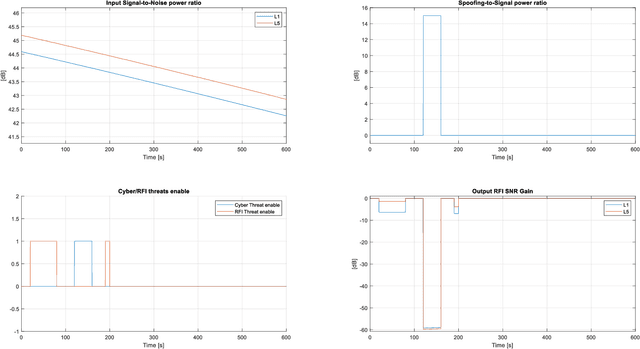
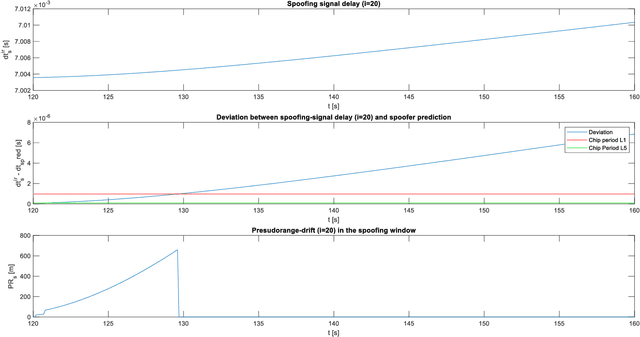
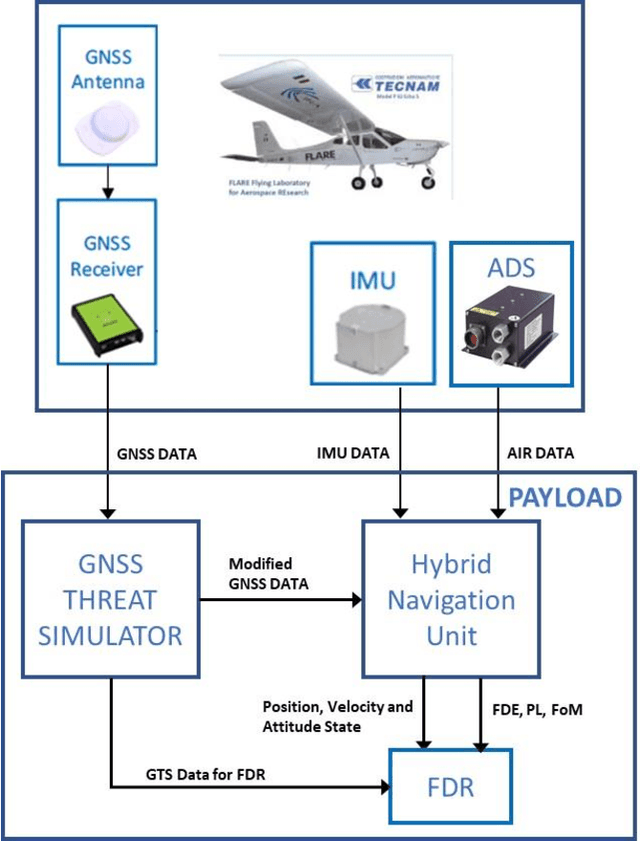
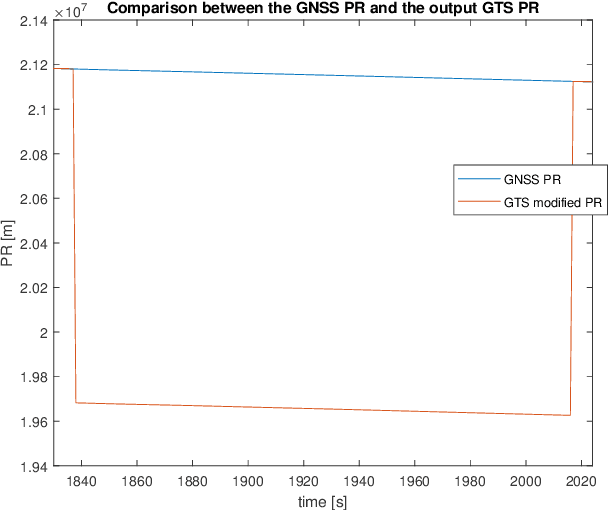
Abstract:In aviation, the impact of threats is becoming increasingly significant, particularly for global navigation satellite system (GNSS). Two relevant GNSS threats are represented by jamming and spoofing. In order to evaluate the technological solutions to counter GNSS attacks, such attacks should be assessed by means of a proper GNSS threat simulator. This work shows the implementation and the testing results of a GNSS security impact simulator which injects the desired threat scenarios as a deviations on the GNSS actual measurements. The proposed simulator can be integrated in both real- and fast-time simulation environments. The provided results confirm the effectiveness of the simulator, and include in-flight demonstrations by means of a flight experimental vehicle.
CycloDSP: A cyclostationary signal analysis tool for GNU Radio
May 27, 2024Abstract:In this paper, we present a first attempt to incorporate in the GNU Radio ecosystem a tool called CycloDSP, devoted to the analysis of complex-valued cyclostationary signals. Such signals are ubiquitous in communication and signal processing, exhibiting periodic or almost periodic statistics that are characterized by a countable set of cycle frequencies, which are related to the main signal periodicities. Common cycle frequencies for modulated signals are multiple of the baudrate and/or combination of the carrier frequency and baudrate. Conventional estimation strategies for cyclostationary signal analysis typically exhibit a high computational burden. Many approaches aimed at reducing complexity exploit fast Fourier transform (FFT) algorithms, which are very efficient for batch data but are not suited for continuously streaming data, typically encountered in software-defined radio (SDR) applications. The aim of this paper is to develop an out-of-tree (OOT) GNU Radio module containing a set of building block functions, aimed at estimating functions, such as the cyclic correlation functions, typically employed for cyclostationary signal analysis. The proposed implementation must be designed so as to ensure high efficiency in processing continuous data streams of complex samples, both in terms of computational load and data storage, in order to be executed on general purpose computers. We tested our implementation by estimating in real-time the second-order cyclic statistics of a Gaussian minimum-shift keying (GMSK) modulated signal, which belongs to a class of signals commonly employed in aeronautical telemetry datalinks.
A Hybrid NOMA-OMA Scheme for Inter-plane Intersatellite Communications in Massive LEO Constellations
Jul 17, 2023Abstract:Communication between satellites in low-Earth orbit (LEO) constellations takes place through intersatellite links (ISLs). Unlike intra-plane ISLs, which interconnect satellites belonging to the same orbital plane with fixed relative distance, inter-plane ISLs experience significant Doppler frequency shifts, since satellites belonging to different orbital planes exhibit time-varying relative distance (required, e.g., to minimize the risk of physical collisions between satellites). In this paper, we consider the problem of connecting multiple satellites, belonging a massive LEO Walker Delta constellation, to a receiving satellite, referred to as the sink. Specifically, we consider a hybrid multiple access scheme, which employs a combination of non-orthogonal multiple access (NOMA), where ISLs share the same time-frequency resource blocks, and orthogonal multiple access (OMA), where ISLs employs orthogonal resource blocks. To this aim, the set of satellites transmitting towards the sink is divided into groups, where NOMA is employed within each group, whereas OMA is used to separate different groups. Such a scheme subsumes as special cases both pure-OMA and pure-NOMA. Our study highlights that similar Doppler frequency shifts have a large impact on the individual rates of the satellites in a pure-NOMA scheme, thus reducing the network fairness of this technique. Motivated by such a fact, we develop design strategies of the proposed hybrid NOMA-OMA scheme, which exploit inter-plane Doppler frequency diversity to enhance fairness among the satellites, while ensuring a significantly higher sum-rate capacity compared to the pure-OMA technique. Numerical results corroborate our theoretical analysis, by demonstrating both the fairness enhancement of the proposed techniques over the pure-NOMA scheme, as well as their capacity improvement over the pure-OMA one.
A cloud-assisted ADS-B network for UAVs based on SDR
May 20, 2022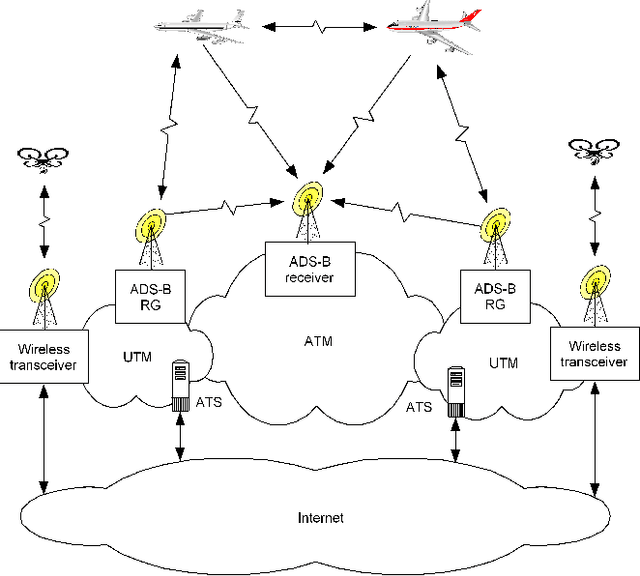
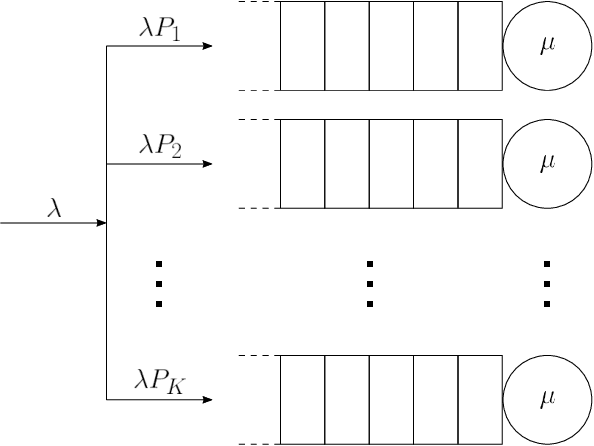
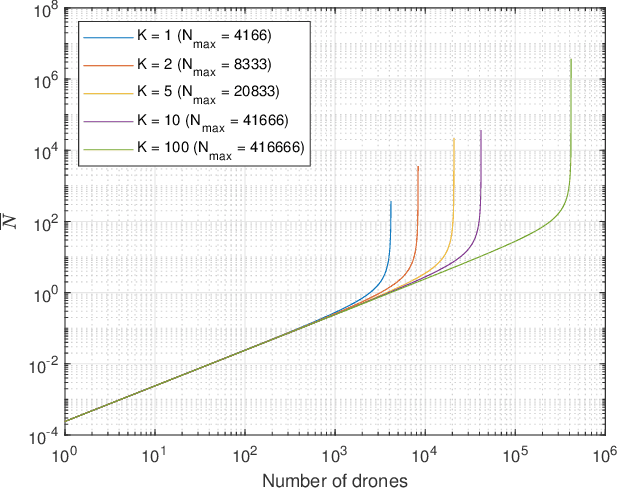

Abstract:Integration of Unmanned Aerial Vehicles (UAVs) or "drones" into the civil aviation airspace is a problem of increasing interest in the aviation community, as testified by many initiatives developed worldwide. Many traditional surveillance solutions for manned aircrafts employ the Automatic Dependent System-Broadcast (ADS-B) technology, which however might present several drawbacks when used for UAVs, especially smaller ones and/or those flying at very low altitudes. We present in this paper a cloud-based surveillance solution for UAVs, which can be considered as an enhancement of a conventional ADS-B system. The proposed solution leverages inexpensive on-board transceivers for transmitting positional messages from the UAVs to the ground. A network of ADS-B gateways, based on the software-defined radio (SDR) paradigm, format the positional messages into valid ADS-B signals and rebroadcast them in the air, allowing thus to emulate a true ADS-B system and overcoming the main disadvantages of the conventional implementation. A preliminary performance analysis of the proposed approach, based on queuing theory, shows the main tradeoffs of the considered approach. Moreover, a physical-layer laboratory implementation of the proposed solution is presented, based on off-the-shelf SDR hardware, which is programmed using the open-source GNU Radio environment.
Reception strategies for sky-ground uplink non-orthogonal multiple access
Aug 15, 2021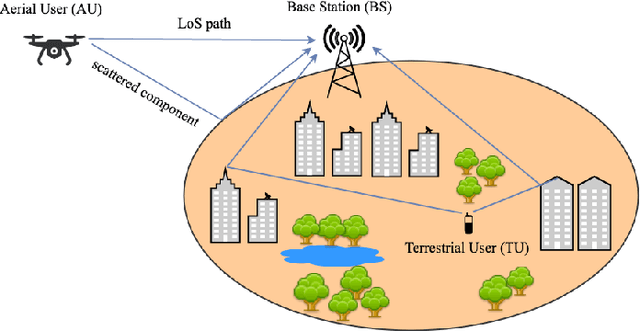
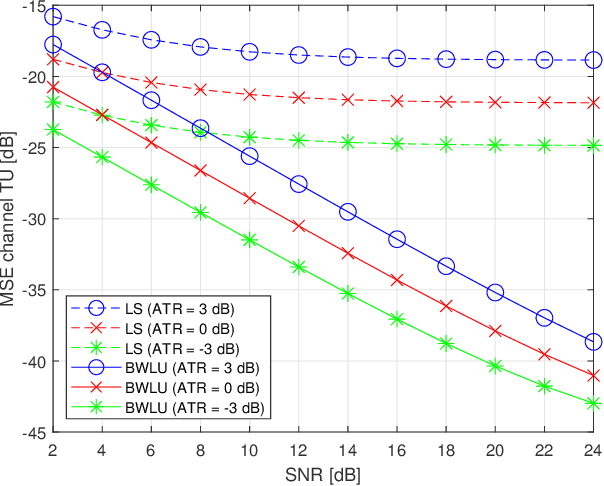

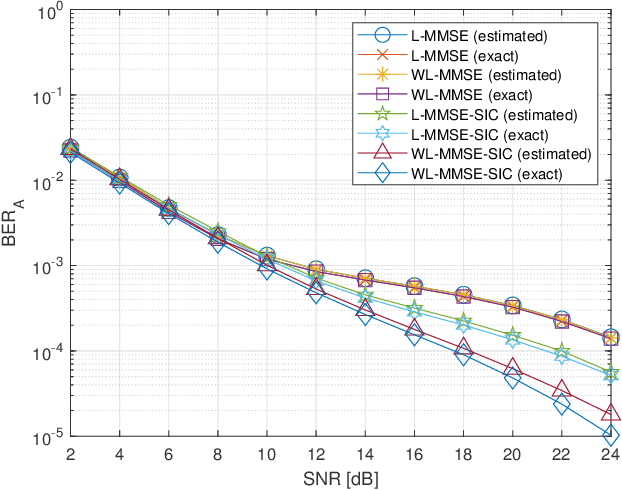
Abstract:Integration of unmanned aerial vehicles (UAVs) into fifth generation (5G) and beyond 5G (B5G) cellular networks is an intriguing problem that has recently tackled a lot of interest in both academia and industry. An effective solution is represented by cellular-connected UAVs, where traditional terrestrial users coexist with flying UAVs acting as additional aerial users, which access the 5G/B5G cellular network infrastructure from the sky. In this scenario, we study the challenging application in which an UAV acting as aerial user (AU) and a static (i.e., fixed) terrestrial user (TU) are paired to simultaneously transmit their uplink signals to a ground base station (BS) in the same time-frequency resource blocks. In such a case, due to the highly dynamic nature of the UAV, the signal transmitted by the AU experiences both time dispersion due to multipath propagation effects and frequency dispersion caused by Doppler shifts. On the other hand, for a static ground network, frequency dispersion of the signal transmitted by TU is negligible and only multipath effects have to be taken into account. To decode the superposed signals at the BS by using finite-length data record, we propose a novel sky-ground (SG) nonorthogonal multiple access (NOMA) receiving structure that additionally exploits the different circularity/noncircularity and almost-cyclostationarity properties of the AU and TU by means of improved channel estimation and time-varying successive interference cancellation. Numerical results demonstrate the usefulness of the proposed SG uplink NOMA reception scheme in future 5G/B5G networks.
Detection and blind channel estimation for UAV-aided wireless sensor networks in smart cities under mobile jamming attack
May 25, 2021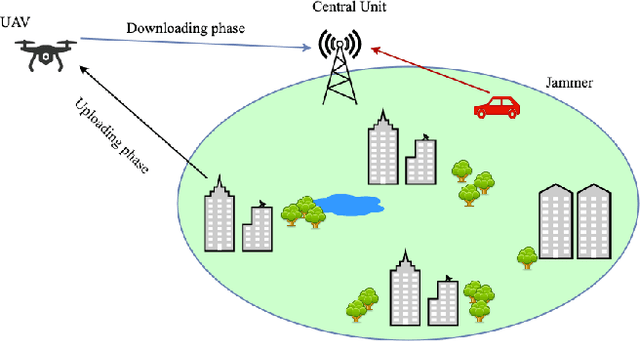
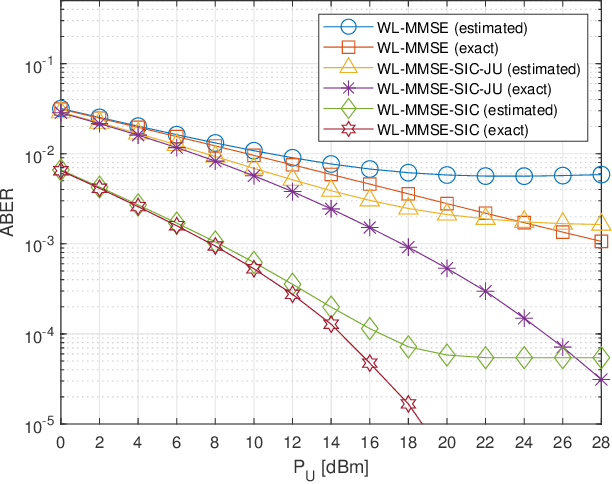
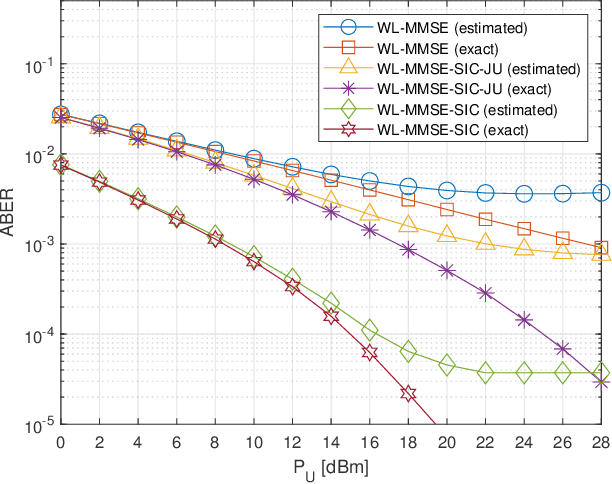
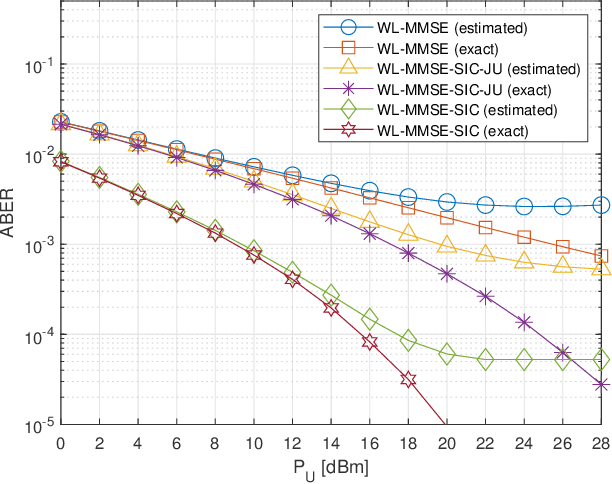
Abstract:There exist several ways of integrating unmanned aerial vehicles (UAVs) into wireless sensor networks (WSNs) for smart city applications. Among the others, a UAV can be employed as a relay in a "store-carry and forward" fashion by uploading data from ground sensors and meters and, then, downloading it to a central unit. However, both the uploading and downloading phases can be prone to potential threats and attacks. As a legacy from traditional wireless networks, the jamming attack is still one of the major and serious threats to UAV-aided communications, especially when the jammer is mobile, too, e.g., it is mounted on an UAV or inside a terrestrial vehicle. In this paper, we investigate anti-jamming communications in UAV-aided WSNs operating over doubly-selective channels. In such a scenario, the signals transmitted by the legitimate transmitters (sensors and meters in the uploading phase or the UAV in the downloading phase) and the malicious mobile jammer undergo both time dispersion due to multipath propagation effects and frequency dispersion caused by Doppler shifts. To suppress the jamming signal, we propose a blind physical-layer technique that jointly exploits amplitudes, phases, time delays, and Doppler shifts differences between the two superimposed signals. Such parameters are estimated from data through the use of algorithms exploiting the almost-cyclostationarity properties of the received signal. Simulation results corroborate the antijamming capabilities of the proposed method, for different mobility scenario of the jammer.
 Add to Chrome
Add to Chrome Add to Firefox
Add to Firefox Add to Edge
Add to Edge